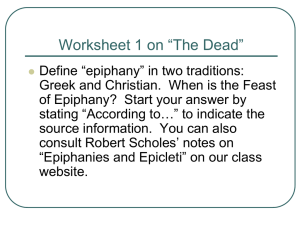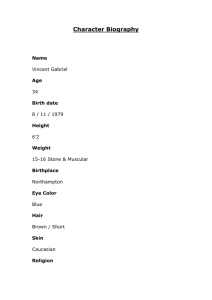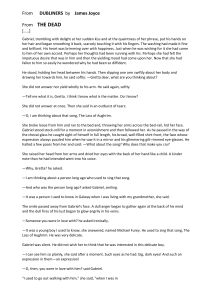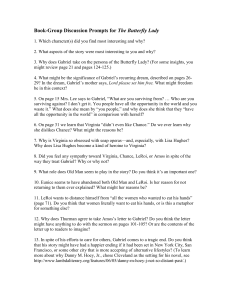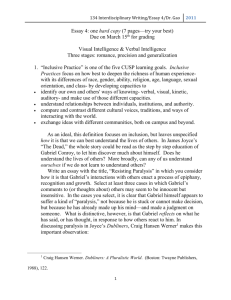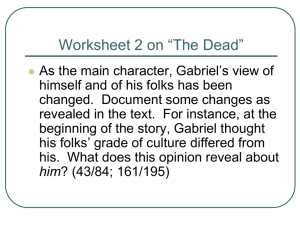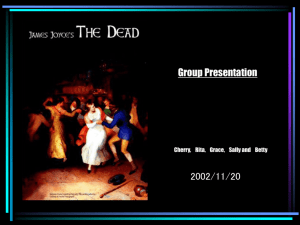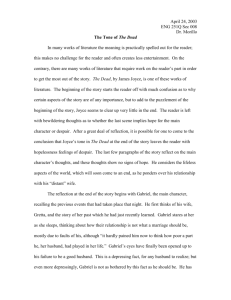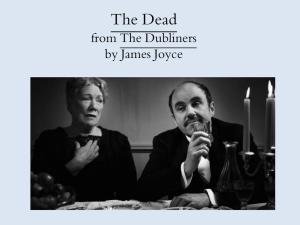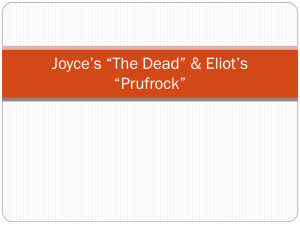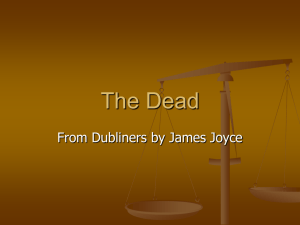File
advertisement
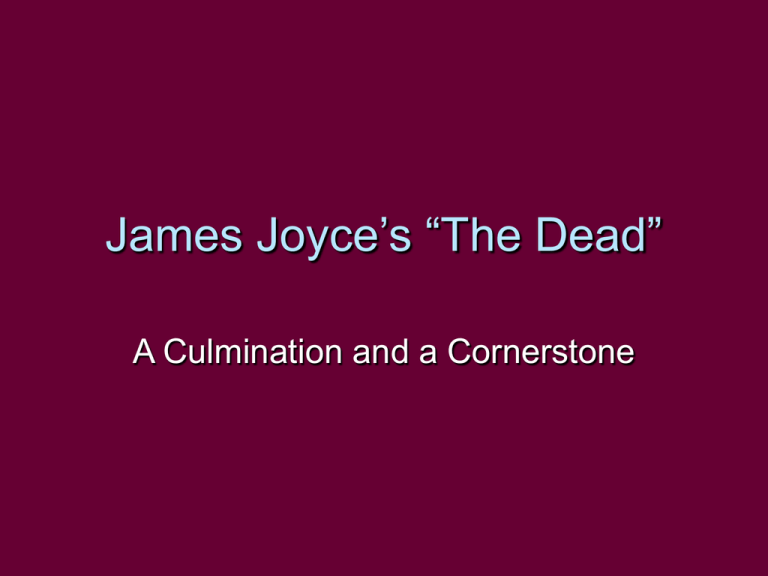
James Joyce’s “The Dead” A Culmination and a Cornerstone Common Elements: How is this story similar to other stories in Dubliners? “The Sisters” Like Eliza and Nannie in the first story in the collection, Julia and Kate are two sisters around whom a large part of the story circulates. Women in both stories seem to have limited opportunities. (All the sisters are spinsters, and Mary Jane and Lily seem destined to be as well. Lily can only make subsistence earnings living off the family.) The church partly to blame for the paralysis of Father Flynn likewise holds the Morken sisters back in their musical career. “An Encounter” Gabriel’s querying of Lily loosely suggests a foray into an inappropriate subject with Lily, or at least her response makes it seem so. Gabriel would like to escape the party and go walking in the snow (like the miching boys). Mention of both the Catholics and the Protestants in both stories (priest and the Swaddlers in “An Encounter” and the Pope, a priest and Trinity University – a Protestant institution – in “The Dead.”) “Araby” Michael Furey’s love for Gretta is romantic like that of the unnamed narrator for Mangan’s sister in “Araby.” Michael Furey, whose name signifies a passion that burns out quickly, made a quest to Gretta (like the boy’s quest to Araby), despite his ill health and the bad weather. Gretta was leaving Galway to go to the convent, just as Mangan’s sister cannot attend the bazaar because she must go on a retreat with her church (church as oppressor of true living). “Eveline” Both Eveline and Gabriel are trapped behind windows, longing for veritable escapes. The wistful preoccupation with what could have been will surely be a part of Eveline’s adulthood much as it is a part of Gretta’s. Both women had a chance at a much different existence and did not/could not take it. A death in both cases is largely responsible for preventing love. “The Boarding House” Julia, Kate, Mary Jane, and Lily live in a boarding house, though we get the idea that it is a place of much greater propriety than Mrs. Mooney’s boarding house. Again readers are lead to see the limited opportunities for women (especially if they are not being supported by a husband or the church). Both stories highlight a son who is a “hard case” (Jack Mooney in “The Boarding House” and Freddy Malins in “The Dead.”) “A Little Cloud” Gabriel in many ways is like Little Chandler: he is basically a clean-living, good person who feels in the end that he is unfulfilled in his life and in his marriage. Both men understand that the confines of Dublin and Ireland are limiting. “Counterparts” Freddy Malins is a slightly more upright version of Farrington. Circular imagery pervades both stories (Farrington’s watch and coins and his general cycle of living – the traditions involved in the Morken’s Christmas feast, the quadrilles [which is actually a box step, but begins where it ends], the story of Johnny the horse, and the idea of life and death connected to the seasons) The third person narrator shows some detachment in each story by using general terms at times for major characters. (Farrington is “The man” through the first part of the story, underscoring his detachment from his own life; and Mr. Alleyne is “the head” and “the skull.” When Gabriel is watching Gretta in the stairwell while Mr. Darcy sings “The Lass of Aughrim” she is described as “a woman” in the shadow and “a symbol of something” which helps to foreshadow the idea that her husband Gabriel doesn’t really know her that well, despite years of marriage.) “A Painful Case” A love-triangle exists in each story in which the husband is unaware (at least until a point). The idea of lost love and what could have been leads to the epiphany is both stories. A lover has literally died (while others in the lovetriangle are figuratively dead). The death is part of or caused by the love (Michael Furey dies for Gretta, while Mrs. Sinico dies of a broken heart.) “A Mother” The Irish National Movement is the most obvious connection. (Ms. Ivors hammers politics to Gabriel, calling him a “West Briton,” and seems to do little more than spew propaganda and use a little token Irish for effect. Mrs. Kearney in “A Mother” tries to capitalize on the Irish Revival and on her daughter’s Irish-sounding name.) Kathleen Kearney is in both stories! (The story revolves around her the first time she appears in the collection, and in “The Dead” she is mentioned as one of the people who will accompany Ms. Ivors to the Arran Isles in the summer.) In both stories Irish culture is shown in decline. (In “A Mother” the sparse attendance at the concert, the number of people “holding paper,” and the poor quality of the performers reflects this; in “The Dead” Mr. D’Arcy says all the best singers have left Ireland.)
